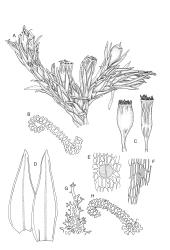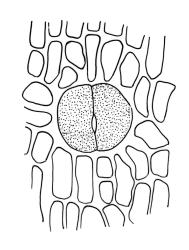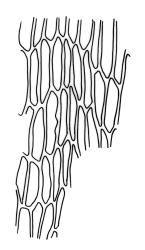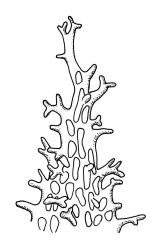- ≡ Orthotrichum fimbriatum R.Br.bis, Trans. & Proc. New Zealand Inst. 27: 430 (1895) nom. illeg., non Orthotrichum fimbriatum P.Beauv. 1805
Plants grey-green, ± glaucous. Leaf apices erose-dentate. Mid laminal cells with conspicuously branched papillae (especially on young leaves) that are (5–)7–15(–18) µm tall; cells near leaf apex with papillae to 35(–65) µm.
SI: Nelson (Wairau Gorge), Marlborough (Branch River, Upper Awatere River, Charwell River, Hundalee, Kaikōura), Canterbury (Upper Clarence River, Waiau, Porters Pass, Broken River Basin, Black Birch Stream, near Twizel), Otago (near Lindis Pass, near Wanaka, Pigroot Creek).
Endemic. Further locality details are provided by Lewinsky (1984, p. 405 & fig. 12).
In all respects other than size of papillae and the associated glaucous colour, the variety falls within the variation of the species. The height and the much-branched nature of the upper laminal papillae are conspicuous even under the stereoscope. There seems to be no correlation between papillosity of the leaves and the nature of the calyptra hairs. When well-developed, the variety appears distinct but the distinction of the varieties primarily on the basis of laminal papillae height and the associated glaucous colour in plants with tall papillae (see discussion by Lewinsky 1984, pp. 385–387) seems arbitrary, and her histogram of papillae height and number is only weakly bimodal. A more detailed morphometric study of O. rupestre s.l. may show the variety to be merely a response to extreme environmental conditions and unworthy of taxonomic segregation. However, such a study is outside the ambit of this work and the varieties are recognised here as a convenience rather than from strong conviction.
Lewinsky annotated much material of this variety in N.Z. herbaria as "O. rupestre var. fimbriatum" but this combination was never published.









